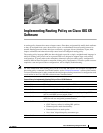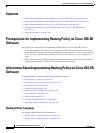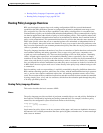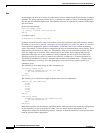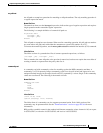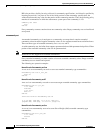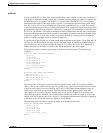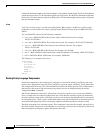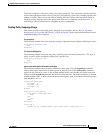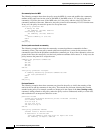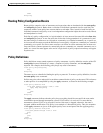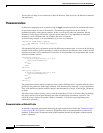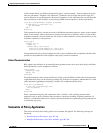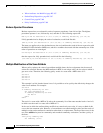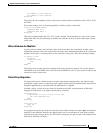
Implementing Routing Policy on Cisco IOS XR Software
Information About Implementing Routing Policy on Cisco IOS XR Software
RC-360
Cisco IOS XR Routing Configuration Guide
OL-14356-01
Neither the minimum length nor maximum length is valid without a mask length. For IPv4, the minimum
length must be less than 32, the maximum length of an IPv4 prefix. For IPv6, the minimum length must
be less than 128, the maximum length of an IPv6 prefix. The maximum length must be equal to or greater
than the minimum length.
rd-set
An rd-set is used to create a set with route distinguisher (RD) elements. An RD set is a 64-bit value
prepended to an IPv4 address to create a globally unique Border Gateway Protocol (BGP) VPN IPv4
address.
You can define RD values with the following commands:
• a.b.c.d:m:*—BGP VPN RD in IPv4 format with a wildcard character. For example,
10.0.0.2:255.255.0.0:*.
• a.b.c.d/m:n—BGP VPN RD in IPv4 format with a mask. For example, 10.0.0.2:255.255.0.0:666.
• a.b.c.d:* —BGP VPN RD in IPv4 format with a wildcard character. For example,
10.0.0.2:255.255.0.0.
• a.b.c.d:n— BGP VPN RD in IPv4 format. For example, 10.0.0.2:666.
• asn:*— BGP VPN RD in ASN format with a wildcard character. For example, 10002:255.255.0.0.
• asn:n—BGP VPN RD in ASN format. For example, 10002:666.
The following is an example of an rd-set:
rd-set rdset1
10.0.0.0/8:*,
10.0.0.0/8:777,
10.0.0.0:*,
10.0.0.0:777,
65000:*,
65000:777
end-set
Routing Policy Language Components
Four main components in the routing policy language are involved in defining, modifying, and using
policies: the configuration front end, policy repository, execution engine, and policy clients themselves.
The configuration front end (CLI) is the mechanism to define and modify policies. This configuration is
then stored on the router using the normal storage means and can be displayed using the normal
configuration show commands.
The second component of the policy infrastructure, the policy repository, has several responsibilities.
First, it compiles the user-entered configuration into a form that the execution engine can understand.
Second, it performs much of the verification of policies; and it ensures that defined policies can actually
be executed properly. Third, it tracks which attach points are using which policies so that when policies
are modified the appropriate clients are properly updated with the new policies relevant to them.
The third component is the execution engine. This component is the piece that actually runs policies as
the clients request. The process can be thought of as receiving a route from one of the policy clients and
then executing the actual policy against the specific route data.




